V: Green Eyes III
More dark skin with not brown eyes, and then the blue-tone greens.
Out of the less-than-coffee-black eyes on African descendants, I'm more used to seeing Amber than I am green or blue, but this isn't that uncommon.
1:

Dark skin with anolive overall look: rifle green, olive drab camouflage, and a darker rim (black olive)--up close this isn't that spectacular a color, but from a distance, it's awesome. I love when people's eyes are a lighter color than their skin. Always have.
Moldavite
There's a spot under the pupil, an eye freckle, so yay, learnin' time:
"When the eye freckle is on the iris (the colored part of the eye), it's called an iris nevus. Approximately 6 in 10 people have one. [...] These are tiny flecks in the colored part of your eye. They're more like the freckles on your skin than moles -- they're only on the surface of your eye and don't affect its shape.
[...]
Most eye freckles are benign, but if you have one, it needs to be monitored by an eye doctor with frequent exams, usually every six months to a year, to document the size, shape, and any color changes of the freckle." ~ Golden Eye Optometry
But rarely, these eye freckles can be related to colon cancer, a condition called: congenital hypertrophy of the retinal pigment epithelium (CHRPE) that can point to a condition called familial adenomatous polyposis (FAP)--and that's how colon cancer (1% of all colon cancers, indicators though, are 100% chance without colon removal) gets dragged into spots on your iris. ~ Downtown Eyes
The body is weirdly connected.
2:
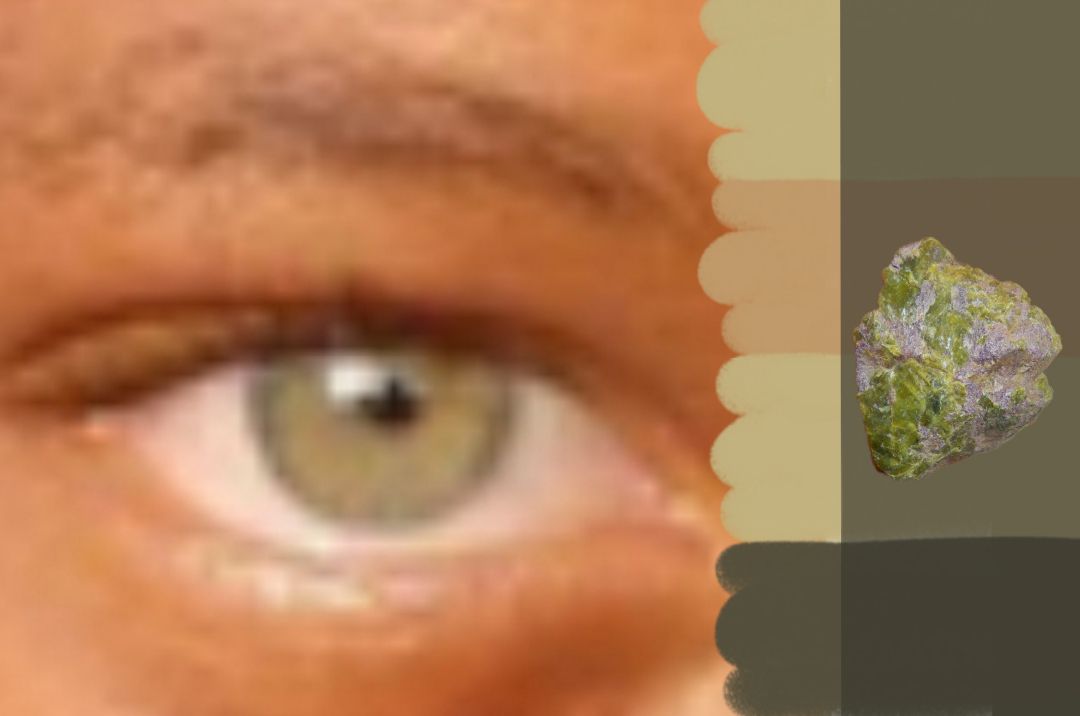
Dark with olive (sand, desert, ecru in an olive drab camouflage rim). I suspect this shade is pretty close to #1, but in this case the dark skin tone is just barely lighter than the eye color.
I knew a Senior (about 18), when I was a Freshmen (about 15) that had this combination. Gorgeous guy. Went to the same church, but schools kept 9th grade seperate so I'd see him about once a week. Would just catch myself staring at him.
Nothing ever came of that. I was jail bait at the time.
Atlantasite: combination of serpentine and stitchtite.
3:
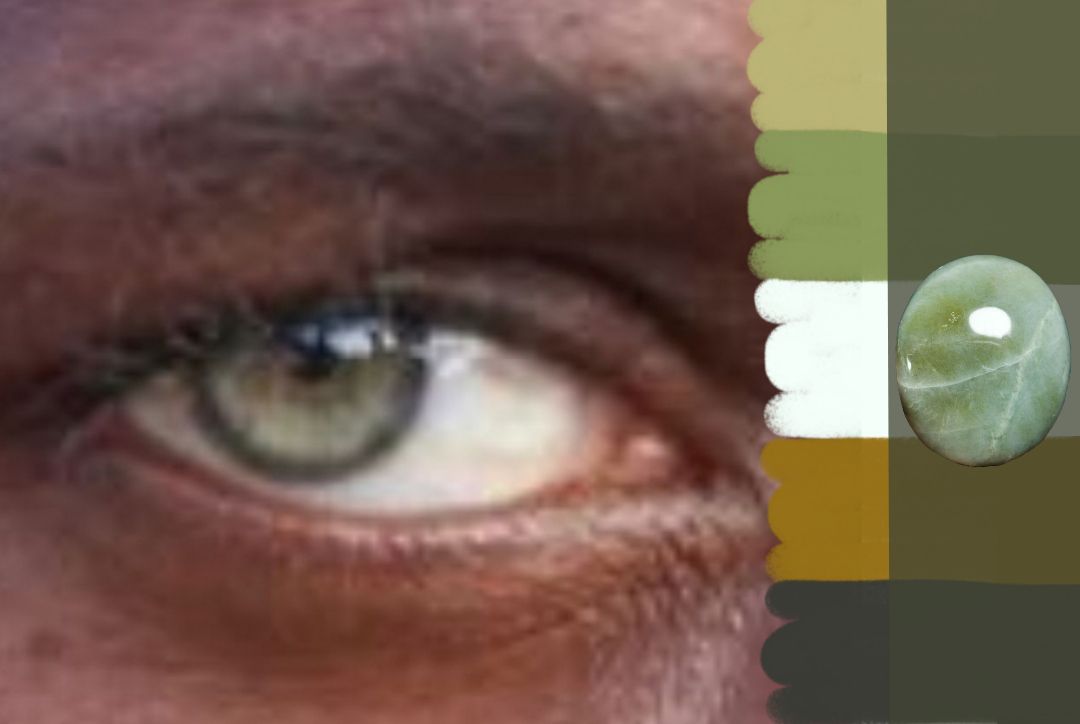
Dark with olve. Unlike the previous two, this combination isn't flat. The light olive (misty moss to moss green) is shiny or luminous (highlights near mint cream), contrasting nicely with both inner (mode beige) and outer rings (black olive).
Green moonstone
4:
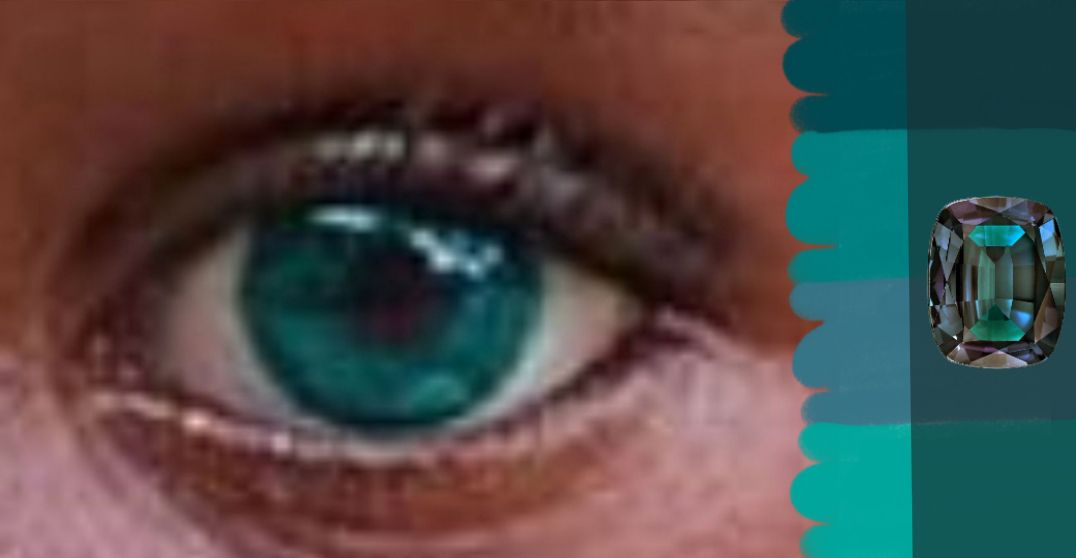
Midnight green or eagle green rim with vibrant teal and real blue, highlights of blue green. Any darker would be that hunter green I'm always looking for. Doubt this is a natural color, but against this dark of skin? That eye color just jumps out.
Alexandrite
5:
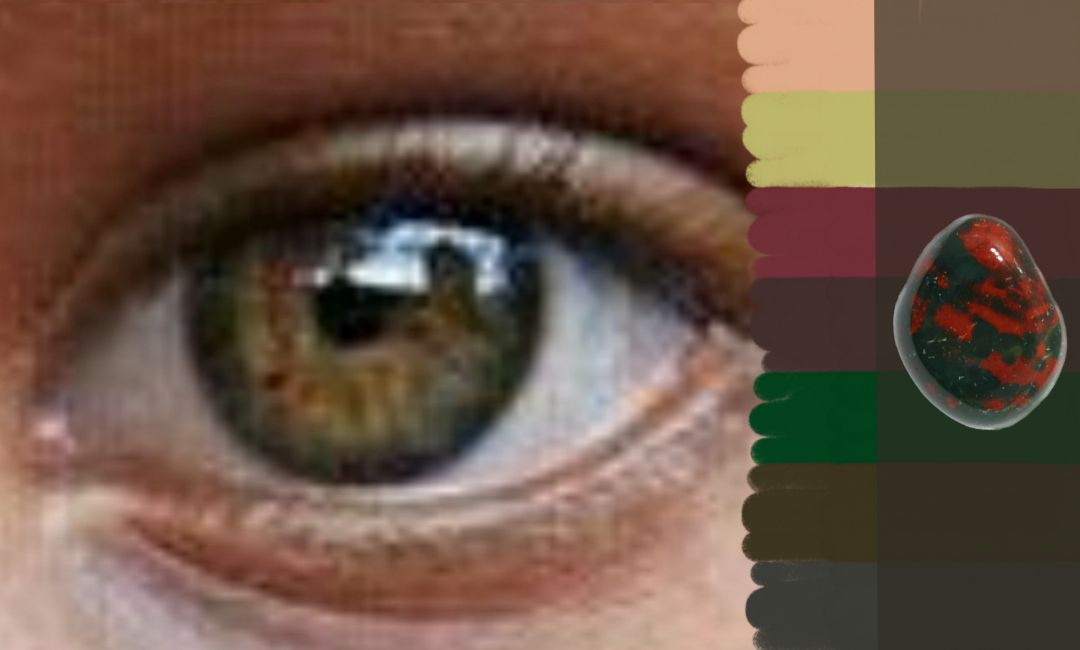
Dark with hazel green. Hint of tumbleweed to dark khaki for the tans and wine to old Burgundy in the browns (inner rim), while the darker outer rim slips from Pakistan green to olive drab #7, then black olive. The shades As usual, from a distance, this will look green much of the time, especially with this dark of skin.
Some thing to note: both #4 and #5 are from young children, probably under the age of 5. I mentioned fatty deposits in the upper eyelid, previously, and both these show a partial tendency towards an eye fold with a fatty layer, but that is due to the young age.
There is a maturation process for even eye shapes/characteristics.
Bloodstone: chosen because it is a green stone with red inclusions (yes, you could use that for flecks of color in the eyes). This child has hazel eyes, that came up in a search for green eyes, even has a ton of green in them, but the mind rebels against that and wants to see this as brown, just that must be a red stone up there.
6:

Dark with vibrant hazel green (illuminating emerald, overall (bouncing between skobeloff and hooker's green, antique bronze closer to the pupil). Flecks of verdigris, acid green for highlights, and an outer rim of Charleston green. In this case, I believe it's a saturation increase: all the right colors, just more of them. It, of course, makes the inner rim look brown, and increases the discolored mark on that part of the eye, almost shifting it to red.
Malachite
Speaking of hooker's green:
1. Mideval hookers who followed the military wore green.
2. Greensleeves (What Child is This?) is one of the few Modal songs to survive to the modern age.
3. Modal just means a different scale (think 🎵Do, a deer, a female deer🎶) than the 2 we commonly use in Western music...and really, we only use 5 notes of the 7 in a scale, for most music.
4. They weren't even called Hookers until Gen. Joseph Hooker, who fought for the Union in the Civil War.
5. They were called whores (hore). Sluts were your lowest servants in the kitchen, not whores.
So, the cleanest thing to call a hooker from that era without triggering everyone is Greensleeves. At least then it comes with the connotation of falling in love with the woman, even if half in jest.
~~~
Switching back to pale skin, for greens that are harder to place as green:
7:
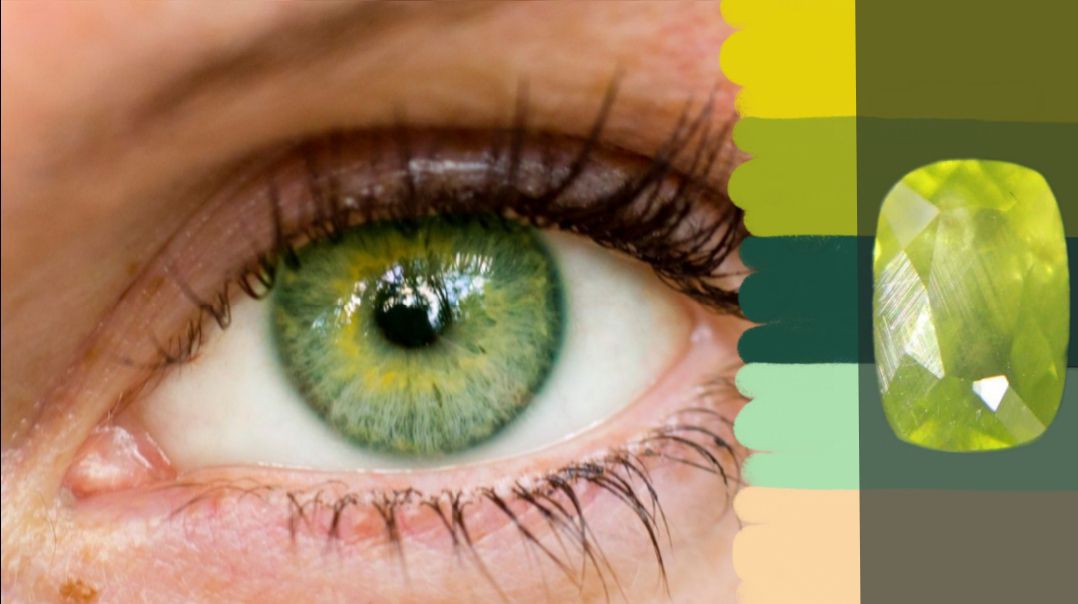
Green blue green to canary yellow wave (citrine), inner rim a shade bluer than citron. Broken darker green root (part of it is English green) that also appears to be in the underlayer (but is barely seen). Close to celadon highlights in the main. Absolutely stunning, and I doubt the saturation is turned up much at all. Faint splash of sunset in the bottom right.
Enstatite
8:
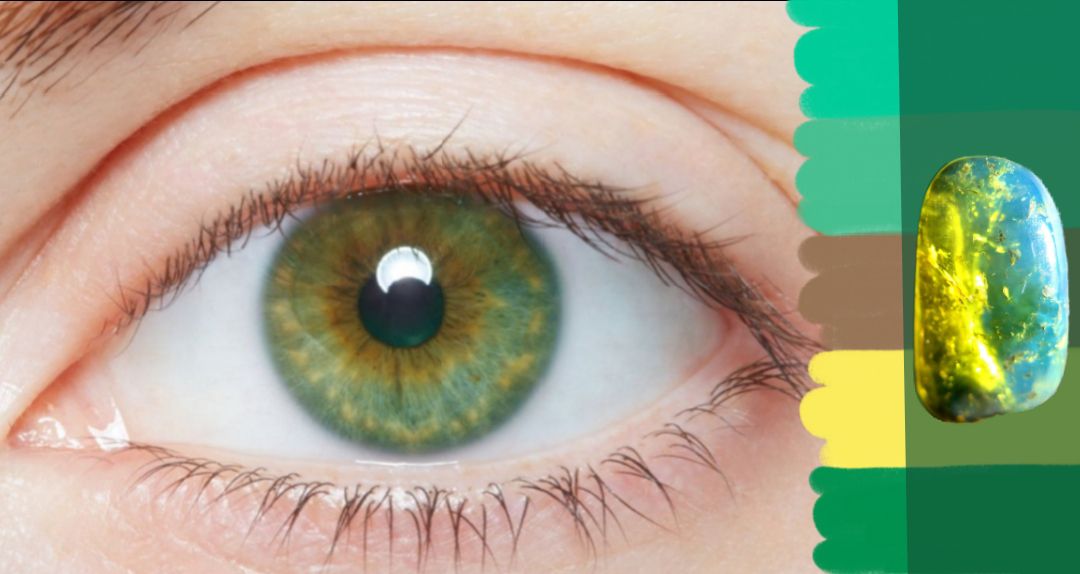
Blue green (Carribbean green,ocean green) to brown (liver chestnut). Same colors as #7, except for the addition of brown. The canary yellow (maize) is broken up, a faint speckling around the edges of both rims. Rim is a faintly broken Spanish green.
Green amber
9:
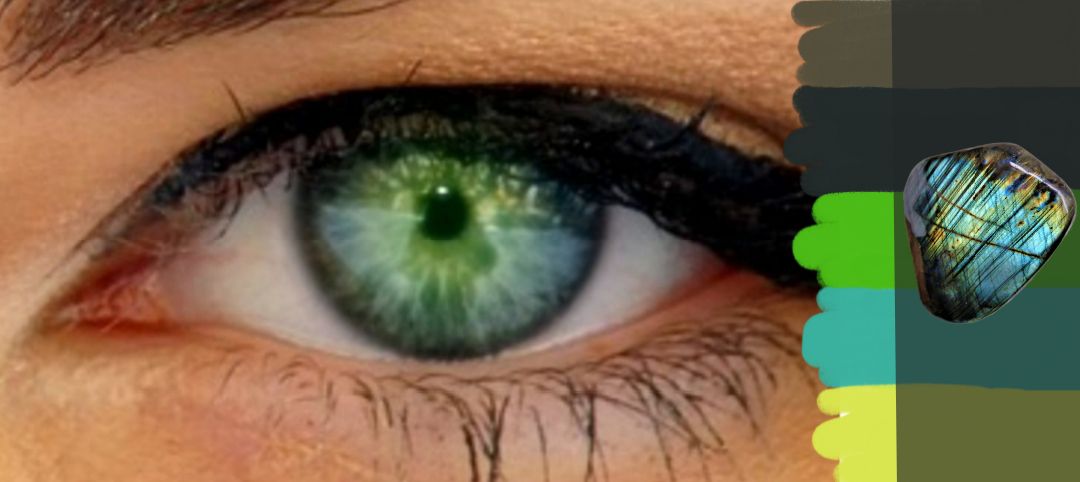
This is likely only blue toned because of reflection. Rim is a mix of olive drab camouflage and Charleston green. Appears green otherwise (kelly green to keppel, highlights towards maximum green yellow). Can clearly see the person shooting, in the reflection.
Labradorite
10:
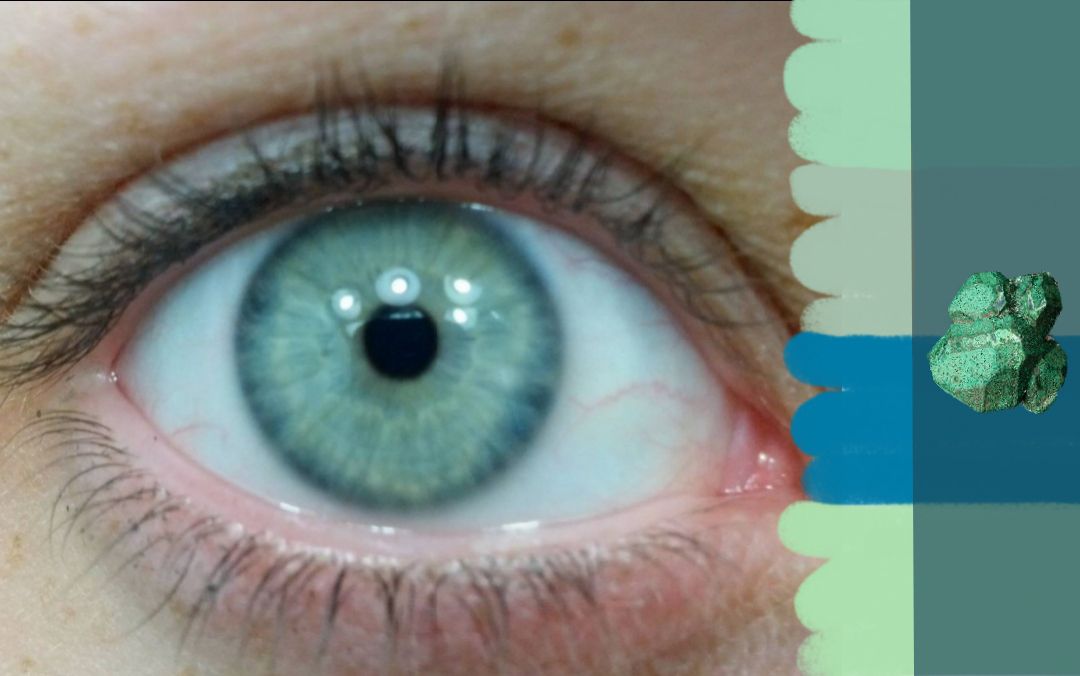
More blue than most greens (turquoise green, Cambridge blue, celadon blue root celadon highlights), still considered green.
Cuprite
Did an edit of my own, to shift the color: both the hue and saturation, turned by about 5 points apiece:
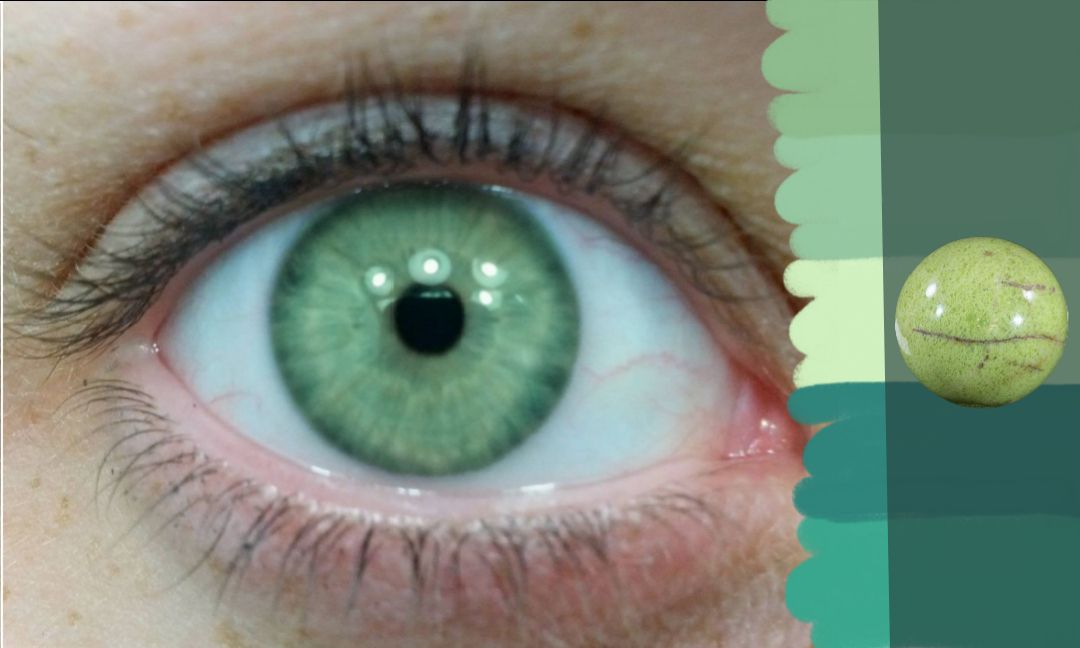
If this was an even softer green, I'd call it mint green or a dark sea green, even Eaton green, highlight of tea green. (celadon green root, and zomp near the edge of that). (Because that would be the color of a college friend's eyes...but his root is either olive or brown...and he's a deep tan, so it really pops.)
Green Opal
11:
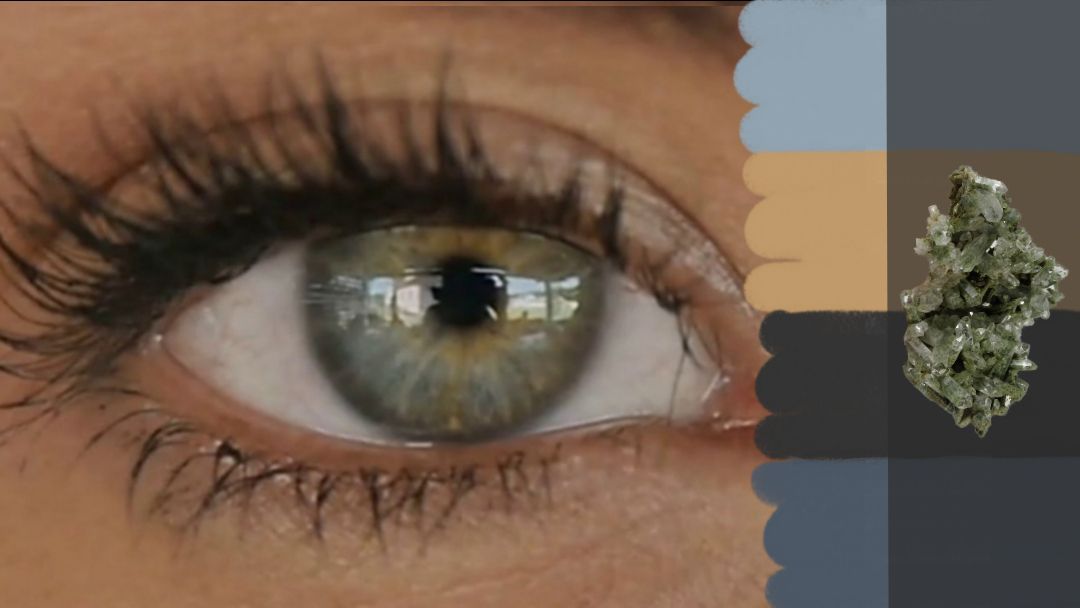
Appears gray green (cadet gray ) to dull yellow (lion). Overall balances out to green, from a distance, but up close, I don't find this to be a pleasent eye color. Kind of like a hocked up loogie splattered on an ice buried patina. The limbus is jet to marengo.
Chlorite included Quartz cluster
12:
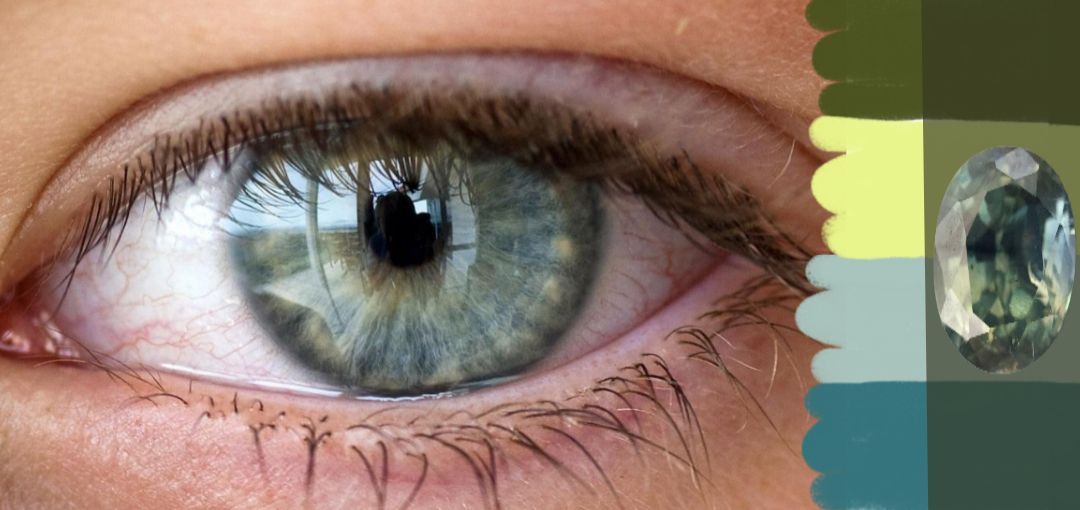
Another more blue than green. It's actually the same colors as the previous eye, but the arrangement doesn't disturb me. Darker rims (army green) with flecks of highlight (key lime) next to it, leaving the midsection to the iced strands (opal) over dark (ming).
Green sapphire
13:
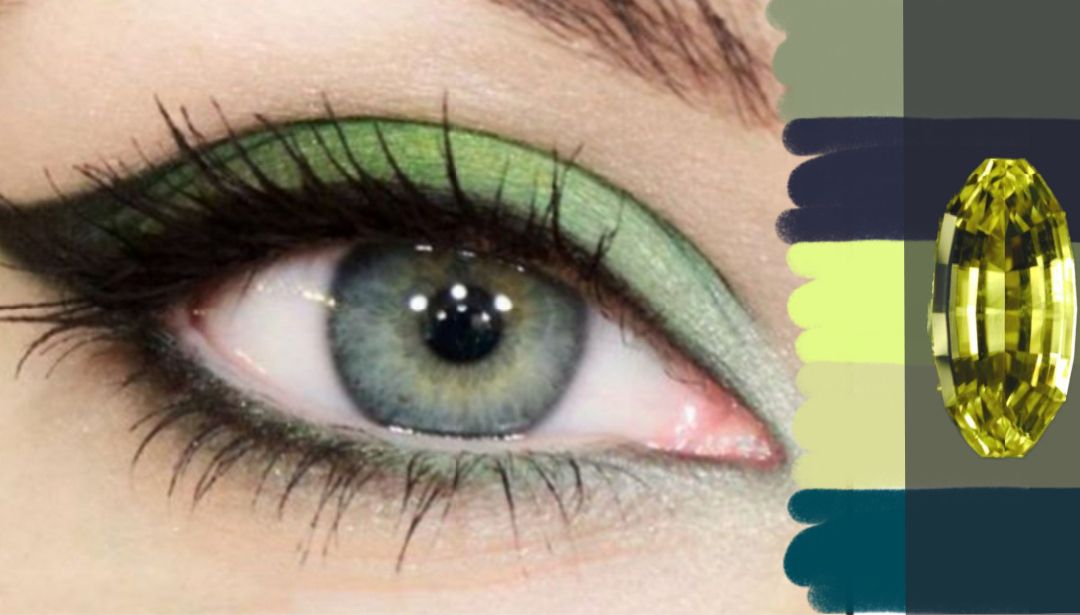
More blue than green, and the green eyeshadow draws attention to its blueness, not its greeness. None of the tones get close to matching. Olive green (artichoke) inner rim, gray blue root (peacoat), yellow strands (mindaro and green earth) pooling to the below the iris in a waveform. The underlying blue is peacock blue.
Amblygonite
14:
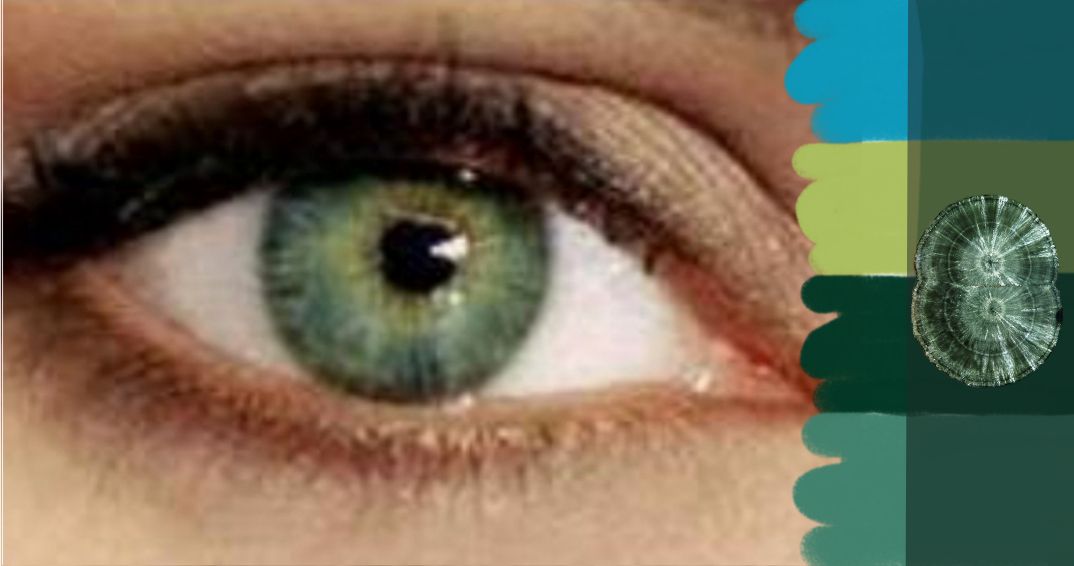
Blue green (jungle green) to olive (middle green yellow), with a Sacramento State green rim, balances out close to viridian. This picture has pixelation, which makes it difficult to tell if it is a contact that caused the colors or if this is the natural eye. It has just enough irregularity to make it natural.
Seraphinite
15:

This is likely a blue-green. The eyeshadow comes up under patina, and the eye is a shade or so darker. Not enough detail to describe patterns, but the overall eye color is awesome...in comparison to the eyeshadow.
(2 weeks of sitting on this...)
The problem is that this eye is a bit of a chameleon. Labeled green under eye searches that focused on patina, it holds faint reflections of the eyeshadow. If I had come across it in later searches, I'd have placed it in with gray eyes.
So, it has an onyx limbus, the main grays are Roman silver and silver sand, while the vague hints of green are close to steel teal and opal.
And yes, there are plenty of people who are labeled eycolors other than what they are most technically: some of that is due to the fact that a lot of eye colors aren't stable.
Epidote
16:
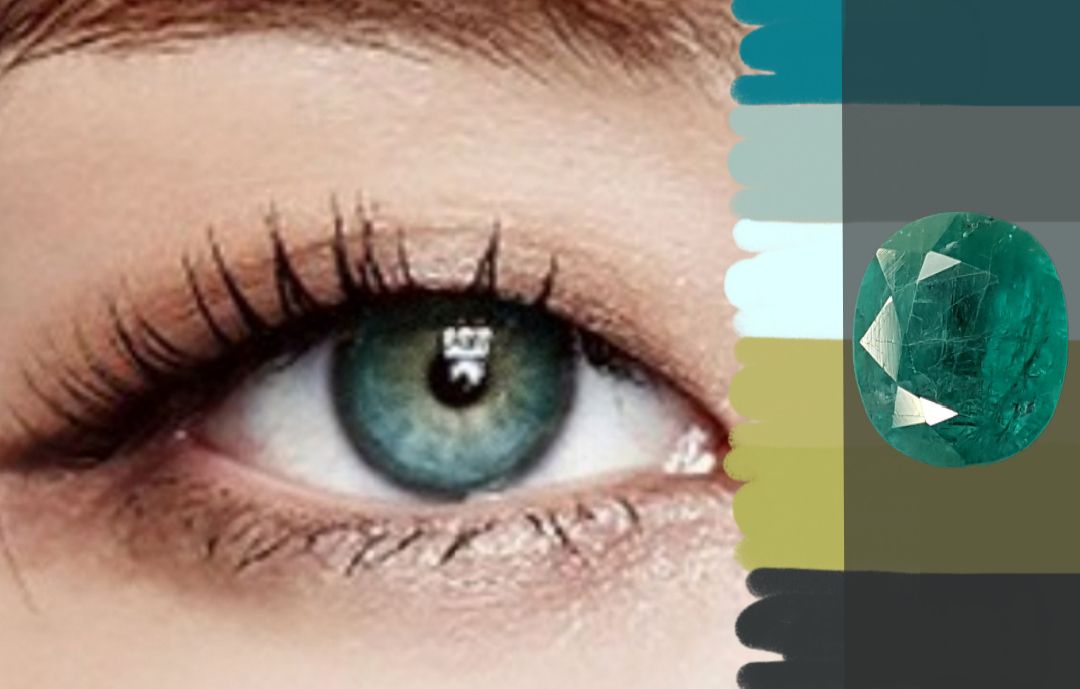
A vibrant patina for that more blue tone? Low is a metallic seaweed, midtone is opal, high is cyan . Pupilary ring is varying shades of dark khaki or olive green. Root is onyx.
Grandadierite
17:
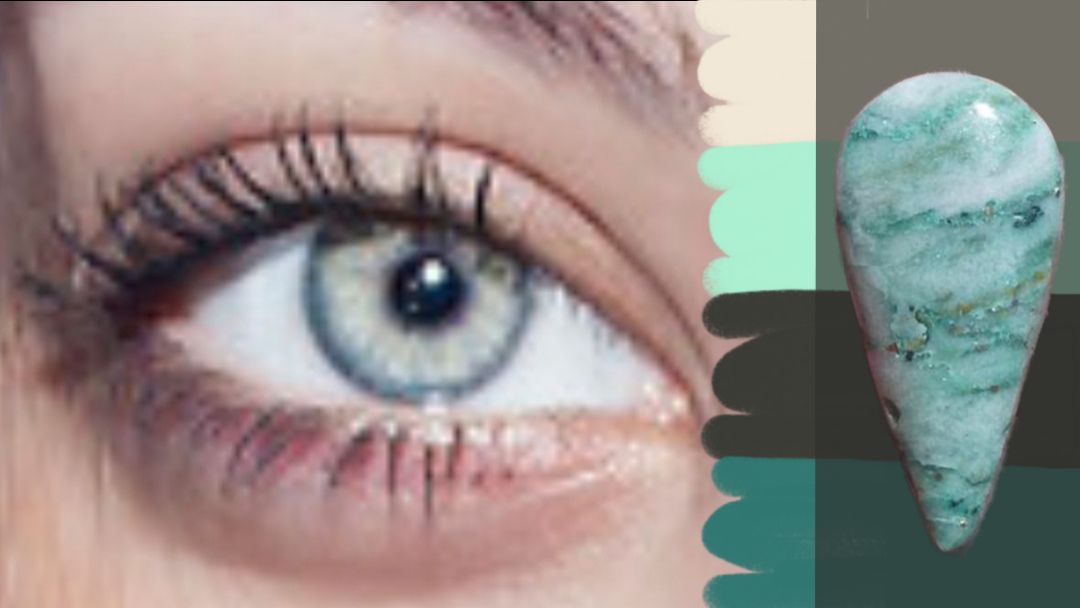
Similar colors, different outcome. Main color appears to be magnolia (flecks of magic mint), which is tan, instead of the olive it should be due to lighting. It has a black olive (flecks of myrtle green) rim.
Mariposite
An eye color all of it's own classification:
18:
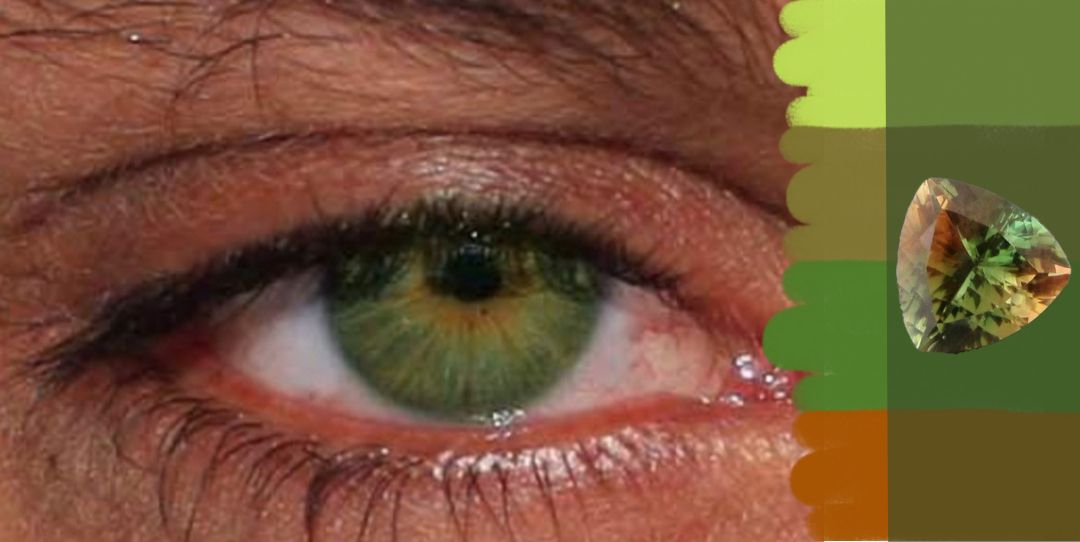
This is far more rich than the olives, but it's not quite a jewel tone, either. Almost a June bud and Spanish bistre on the light green. Sap green behind that. Windsor tan for the brown.
Green sunstone
It's been a few weeks since I picked out the eye, but I think this is a male out of Kazakhstan (north west of China), so this is an Asian country (non-American viewpoint). Genetic ancestry (the ancestry of those who have tested it, within the nation) according to myAncestry is: East European, Baltic, Central Asian and Finnish.
19:
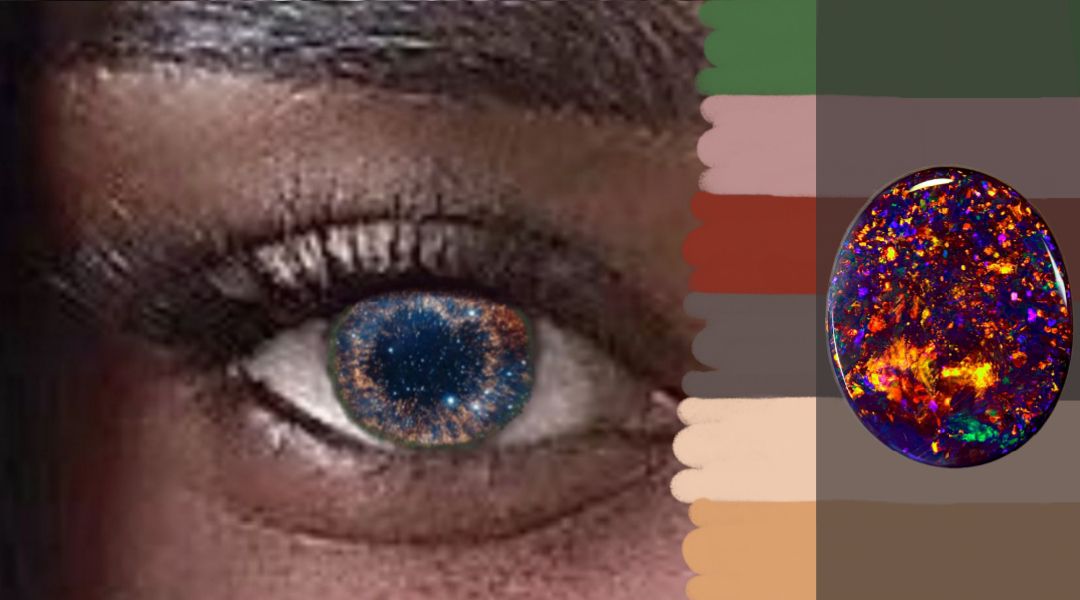
Oh, look, another place to shove a nebula. Hourglass nebula with a hand drawn green root in artichoke green. Some striations are rosy brown, burnt umber, wenge, desert sand, and buff.
Black opal
Bạn đang đọc truyện trên: Truyen247.Pro